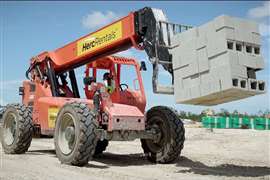Lifting down an old shipyard gantry crane
06 March 2009

Dismantling an old 300 tonne, 70 m high, portal crane was a job engineered and carried out by Vest Kran using three large mobile cranes working closely together assisted by a demolition excavator. Alex Dahm reports.
When the owner of an old portal crane in Norway no longer wanted to pay for its upkeep, they called in Vest Kran to demolish it.
Owner Leirvik Module Technologies (LMT) decided that the O&K portal crane from the 1970s was costing more than they wanted to pay for certification and maintenance so it had to go. It weighed more than 300 tonnes, was 60 m long and stood more than 70 m tall.
Vest Kran used three Terex Demag wheeled telescopic mobile cranes: an AC 600, an AC 350 and an AC 200 to lift down the steel structure. An excavator with a demolition shear clipped off the legs as the old crane was lowered towards the ground.
The job was all engineered and completed by Vest Kran. "We engineered and calculated everything from the information available from the O&K factory drawings from the 1970s, combined with the experience our crew have with structures like these and safety procedures required for a job like this," explained Jørn Losvar, Vest Kran spokesman.
The customer, Leirvik Module Technologies (LMT), was quick to make decisions so the job could be carried out in good time and with minimum impact on the production of oil rig living quarter modules that LMT produces at the facility.
There were several unknown factors that could influence procedures and safety aspects. "Even though the owner said that the gantry was in good condition, we could not exclude any possible weakening in the steel or structure caused by rust or damage from its years of service near the sea," Losvar explained.
Lower and cut
Careful planning was critical for a safe and smooth operation. Planning started six months ahead and the jobsite was visited and inspected several times. The dismantling was carried out over two weeks, while the lifting and clipping of the legs took only two days, from start to finish.
The challenge was how to safely lower the gantry within the safety limits of the capacities of the three mobile cranes used to hold it. "We chose to hook the AC 600 at the top in one end and the AC 350 and AC 200 hooked low on the legs on the other side for the first lift. We had to produce specially fitted hooking attachments to hook the legs about 30 m above ground," Losvar explained.
The AC 200, with jib, was used to carry a man basket while the other two cranes were hooked on. The AC 600 was rigged with 24 m fly jib and sideways superlift. It was hooked in to the top of the lighter end of the portal crane. The AC 350, with superlift and main boom, was hooked in one of the legs at the heavy end. The AC 200 was then hooked on the other leg at the AC 350 end for the first part of the lift.
For the second lift, when the portal had been lowered about 24 m, the 600 was not moved but the 350 was repositioned and it was hooked into the upper part of the heavy end of the gantry on top. The AC 200 was then hooked in the centre of the gantry at the very top. That was to stabilise it and stop it from rolling over as the gantry legs, which acted as ballast, were clipped off using the shear on the Caterpillar excavator as the load was gradually lowered. That happened after the trolley was cut off and the portal was hanging freely from the three cranes.
As with any lift using two or more cranes together, great care was needed to lower the heavy cargo equally, at the same speed, to keep the amount of weight on each crane as per the plan. In addition, the impact of the shear had to be considered and monitored as the operator was clipping the legs off. Since the shipyard contained modules for oil rigs positioned all around the portal crane, a collapse would have been catastrophic.
The job required extensive planning and 600 tonnes of equipment was driven to the site and rigged on the spot. The lift was executed within a weekend towards the end of 2008.
Late at night on the Sunday, David, as the owner had named the gantry, was safely on the ground. All 300 tonnes of steel had landed safely thanks to the skills of a hard working crew. The shear on the excavator clipped the steel tubing into small pieces and it was transported away from the job site the next day.






